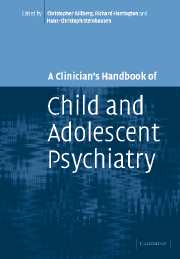Book contents
- Frontmatter
- Contents
- Preface
- List of contributors
- 1 Brain disorders
- 2 Substance use disorders
- 3 Schizophrenia and schizophrenia-like disorders
- 4 Affective disorders
- 5 Anxiety disorders
- 6 Obsessive-compulsive disorders
- 7 Adjustment disorders
- 8 Post-traumatic stress disorder
- 9 Functional somatic symptoms and somatoform disorders in children
- 10 Eating disorders: anorexia nervosa and bulimia nervosa
- 11 Sleep disorders
- 12 Personality disorders
- 13 Mental retardation/learning disability
- 14 Specific developmental disorders of speech and language
- 15 Reading and other learning disorders
- 16 Autism spectrum disorders
- 17 Hyperkinetic disorders
- 18 Conduct disorders
- 19 Elective mutism
- 20 Attachment and disorders of attachment
- 21 Tic disorders
- 22 Elimination disorders: enuresis and encopresis
- 23 Physical and sexual abuse
- 24 Gender identity disorders
- Index
- References
6 - Obsessive-compulsive disorders
Published online by Cambridge University Press: 06 August 2009
- Frontmatter
- Contents
- Preface
- List of contributors
- 1 Brain disorders
- 2 Substance use disorders
- 3 Schizophrenia and schizophrenia-like disorders
- 4 Affective disorders
- 5 Anxiety disorders
- 6 Obsessive-compulsive disorders
- 7 Adjustment disorders
- 8 Post-traumatic stress disorder
- 9 Functional somatic symptoms and somatoform disorders in children
- 10 Eating disorders: anorexia nervosa and bulimia nervosa
- 11 Sleep disorders
- 12 Personality disorders
- 13 Mental retardation/learning disability
- 14 Specific developmental disorders of speech and language
- 15 Reading and other learning disorders
- 16 Autism spectrum disorders
- 17 Hyperkinetic disorders
- 18 Conduct disorders
- 19 Elective mutism
- 20 Attachment and disorders of attachment
- 21 Tic disorders
- 22 Elimination disorders: enuresis and encopresis
- 23 Physical and sexual abuse
- 24 Gender identity disorders
- Index
- References
Summary
Introduction
Research in children and adolescents over the past 20–30 years has documented that OCD (obsessive-compulsive disorder) is considerably more common than believed previously. The need for treatment of this, in many cases rather disabling disorder, has been recognized. The availability of treatment has increased immensely, and a number of studies have documented the role of psychopharmacological treatment and to a lesser extent cognitive behavioural treatment.
Definition and classification
Many children experience ritualistic behaviour during certain phases of their normal development as shown in Table 6.1. This ritualistic behaviour, however, is characterized as being non-disabling and non-distressing to the child. However, this normal ritualistic behaviour seems to help the child in structuring daily life, to perform controlling behaviour and to develop reasonable habits.
OCD is defined by the presence of obsessions and/or compulsions, a definition which applies to both children and adults. The main characteristics of obsessions are shown in Table 6.2. Obsessions are recurrent, persistent ideas, thoughts, images or impulses, which are egodystonic and regarded by the child as futile or repugnant. Egodystonic means that the child recognizes the obsessions as thoughts alien to his or her conscience. Compulsions are repetitive and seemingly purposeful actions which are performed in accordance with certain rules or in a stereotyped fashion. The obsessions and compulsions must be a significant source of distress to the child or they must interfere with social or role functioning.
Diagnostic criteria according to ICD-10 and DSM-IV are shown in Table 6.2.
- Type
- Chapter
- Information
- A Clinician's Handbook of Child and Adolescent Psychiatry , pp. 188 - 206Publisher: Cambridge University PressPrint publication year: 2006
References
- 1
- Cited by



